Water and Salinity Variation along the Soil Profile and Groundwater Dynamics of a Fallow Cropland System in the Hetao Irrigation District, China
Abstract
:1. Introduction
2. Materials and Methods
2.1. Description of the Experimental Site
2.2. Experimental Treatments and Design
2.3. Research Method
2.4. Data Analysis
3. Results
3.1. Distribution Characteristics of Water and Salt in Cultivated Wasteland
3.2. Distribution Characteristics of Soil Salt Ions
3.3. Correlation Analysis of Soil Salt Ions
3.4. Principal Component Analysis of Soil Salt Ions
3.5. Dynamic Changes in Groundwater Depth and Salinity
4. Discussion
5. Conclusions
Author Contributions
Funding
Data Availability Statement
Conflicts of Interest
References
- Guan, Z.; Jia, Z.; Zhao, Z.; You, Q. Dynamics and distribution of soil salinity under long-term mulched drip irrigation in an arid area of northwestern China. Water 2019, 11, 1225. [Google Scholar] [CrossRef]
- Cui, G.; Lu, Y.; Zheng, C.; Liu, Z.; Sai, J. Relationship between soil salinization and groundwater hydration in Yaoba Oasis, Northwest China. Water 2019, 11, 175. [Google Scholar] [CrossRef]
- Abbas, A.; Khan, S.; Hussain, N.; Hanjra, M.A.; Akbar, S. Characterizing soil salinity in irrigated agriculture using a remote sensing approach. Phys. Chem. Earth Parts A/B/C 2013, 55, 43–52. [Google Scholar] [CrossRef]
- Wang, Y.; Deng, C.; Liu, Y.; Niu, Z.; Li, Y. Identifying change in spatial accumulation of soil salinity in an inland river watershed, China. Sci. Total Environ. 2018, 621, 177–185. [Google Scholar] [CrossRef] [PubMed]
- Liu, Y.; Ao, C.; Zeng, W.; Srivastava, A.K.; Gaiser, T.; Wu, J.; Huang, J. Simulating water and salt transport in subsurface pipe drainage systems with HYDRUS-2D. J. Hydrol. 2021, 592, 125823. [Google Scholar] [CrossRef]
- Xu, X.; Huang, G.; Sun, C.; Pereira, L.S.; Ramos, T.B.; Huang, Q.; Hao, Y. Assessing the effects of water table depth on water use, soil salinity and wheat yield: Searching for a target depth for irrigated areas in the upper Yellow River basin. Agric. Water Manag. 2013, 125, 46–60. [Google Scholar] [CrossRef]
- Yuan, C.; Feng, S.; Zhuang, X.; Qian, Z. Analysis on the groundwater salt dynamic in a monitoring area in Hetao Irrigation District of Inner Mongolia. Agric. Res. Arid. Areas 2020, 40, 76–85. [Google Scholar]
- Gowing, J.; Wyseure, G. Dry-drainage a sustainable and cost-effective solution to waterlogging and salinisation. In Proceedings of the 5th International Drainage Workshop, Lahore, Pakistan, 8–15 February 1992; pp. 6.26–26.34. [Google Scholar]
- Ansari, S.; Abedi-Koupai, J.; Mostafazadeh-Fard, B.; Shayannejad, M.; Mosaddeghi, M.R. Assessment of solute transport and distribution under dry drainage conditions using a physical model. Irrig. Drain. 2019, 68, 797–807. [Google Scholar] [CrossRef]
- Konukcu, F.; Gowing, J.; Rose, D. Dry drainage: A sustainable solution to waterlogging and salinity problems in irrigation areas? Agric. Water Manag. 2006, 83, 1–12. [Google Scholar] [CrossRef]
- Soltani, M.; Rahimikhoob, A.; Sotoodehnia, A.; Mendicino, G.; Akram, M.; Senatore, A. Numerical evaluation of the effects of increasing ratio of cropped to uncropped width on dry drainage efficiency in salty soils. Irrig. Drain. 2018, 67, 91–100. [Google Scholar] [CrossRef]
- Li, L.; Shi, H.; Jia, J.; Wang, C.; Liu, H. Simulation of water and salt transport of uncultivated land in Hetao Irrigation District in InnerMongolia. Trans. CSAE 2010, 26, 31–35. [Google Scholar] [CrossRef]
- Ren, D.; Xu, X.; Huang, G. Irrigation water use in typical irrigation and drainage system of Hetao Irrigation District. Trans. Chin. Soc. Agric. Eng. 2019, 35, 98–105. [Google Scholar] [CrossRef]
- Wang, G.; Shi, H.; Li, X.; Yan, J.; Miao, Q.; Chen, N.; Wang, W. Simulation and evaluation of soil water and salt transport in desert oases of Hetao Irrigation District using HYDRUS-1D model. Trans. Chin. Soc. Agric. Eng. 2021, 38, 87–98. [Google Scholar] [CrossRef]
- Wei, F.; Shen, C.; Liu, J.; Wu, J. Analysis of factors influencing the effect of dry drainage salt control based on numerical simulation. China Rural Water Hydropower 2015, 5, 85–90. [Google Scholar]
- Wang, X.; Gao, Q.; Lv, Q.; Li, B. Salt-water Balance and Dry Drainage Desalting in Hetao Irrigating Area, Inner Mongolia. Sci. Geogr. Sin. 2006, 26, 4455–4460. [Google Scholar]
- Yue, W.; Yang, J.; Tong, J.; Gao, H. Transfer and balance of water and salt in irrigation district of arid region. J. Hydraul. Eng. 2008, 39, 623–626+632. [Google Scholar]
- Wu, J.; Zhao, L.; Huang, J.; Yang, J.; Vincent, B.; Bouarfa, S.; Vidal, A. On the effectiveness of dry drainage in soil salinity control. Sci. China Ser. E Technol. Sci. 2009, 52, 3328–3334. [Google Scholar] [CrossRef]
- Wang, C.; Wu, J.; Zeng, W.; Zhu, Y.; Huang, J. Five-year experimental study on effectiveness and sustainability of a dry drainage system for controlling soil salinity. Water 2019, 11, 111. [Google Scholar] [CrossRef]
- Yu, B.; Jiang, L.; Shang, S. Dry drainage effect of Hetao irrigation district based on remote sensing evapotranspiration. Trans. Chin. Soc. Agric. Eng. 2016, 32, 1–8. [Google Scholar] [CrossRef]
- Wang, G.; Shi, H.; Li, X.; Yan, J.; Guo, J.; Li, Z. Study on migration of different types water during farmland-wasteland-lake system in Hetao Irrigation District. Adv. Water Sci 2020, 31, 832–842. [Google Scholar]
- Fox, G.A.; Metla, R. Soil property analysis using principal components analysis, soil line, and regression models. Soil Sci. Soc. Am. J. 2005, 69, 1782–1788. [Google Scholar] [CrossRef]
- Sun, K.; Zhang, J.; Zhang, W.; Zhou, W.; Wang, J. Characteristics of Soil Salinity in Representative Plastic Shed Vegetable Production Areas in Shandong Province, China. Eurasian Soil Sci. 2023, 56, 488–501. [Google Scholar] [CrossRef]
- Ren, D.; Xu, X.; Huang, Q.; Huo, Z.; Xiong, Y.; Huang, G. Analyzing the role of shallow groundwater systems in the water use of different land-use types in arid irrigated regions. Water 2018, 10, 634. [Google Scholar] [CrossRef]
- Ren, D.; Xu, X.; Ramos, T.B.; Huang, Q.; Huo, Z.; Huang, G. Modeling and assessing the function and sustainability of natural patches in salt-affected agro-ecosystems: Application to tamarisk (Tamarix chinensis Lour.) in Hetao, upper Yellow River basin. J. Hydrol. 2017, 552, 490–504. [Google Scholar] [CrossRef]
- Zeng, J.; Liu, X.; Li, J.; XIa, Y.; Wang, L. Dynamic analysis of water and salt in cropland-saline alkali land-sand dunes-lake area based on SWAP model. J. Agric. Resour. Environ. 2018, 35, 540–549. [Google Scholar] [CrossRef]
- Wang, G.; Shi, H.; Li, X.; Guo, J.; Wang, W.; Wu, D. Estimation of Salt Transport and Relationship with Groundwater Depth in Different Land Types in Hetao Irrigation Area. Trans. Chin. Soc. Agric. Mach. 2020, 51, 255–269. [Google Scholar] [CrossRef]
- Liu, G.; Wang, C.; Wang, X.; Huo, Z.; Liu, J. Growing season water and salt migration between abandoned lands and adjacent croplands in arid and semi-arid irrigation areas in shallow water table environments. Agric. Water Manag. 2022, 274, 107968. [Google Scholar] [CrossRef]
- Xiao, X.; Xu, X.; Ren, D.; Huang, Q.; Huang, G. Modeling the behavior of shallow groundwater system in sustaining arid agroecosystems with fragmented land use. Agric. Water Manag. 2021, 249, 106811. [Google Scholar] [CrossRef]
- Slama, F.; Gargouri-Ellouze, E.; Bouhlila, R. Impact of rainfall structure and climate change on soil and groundwater salinization. Clim. Chang. 2020, 163, 395–413. [Google Scholar] [CrossRef]
- Wang, R.; Wan, H.; Chen, S.; Xia, Y.; Bai, Q.; Peng, Z.; Shang, S. Spatial distribution pattern of soil salinization in farmland of Wulate sub-irrigation areas in Hetao Irrigation District in Inner Mongolia in spring. Trans. Chin. Soc. Agric. Eng. 2021, 38, 105–113. [Google Scholar] [CrossRef]
- Gao, H.; Liu, X.; Gao, X.; Qu, Z. Analysis o fSalinity and Ions Migration Law and Equilibrium in Salinized Soil Under Different Irrigationand Drainage Modes. J. Soil Water Conserv. 2023, 37, 361–370. [Google Scholar] [CrossRef]
- Wang, Y.; Liu, X.; Hu, X.; Qiao, T. Water and salt distribution and salt accumulation characteristics of cultivated-waste-sandy lands in salinized irrigated area. Agric. Res. Arid Areas 2020, 38, 207–214. [Google Scholar] [CrossRef]
- Abdel-Fattah, M.K.; Mohamed, E.S.; Wagdi, E.M.; Shahin, S.A.; Aldosari, A.A.; Lasaponara, R.; Alnaimy, M.A. Quantitative evaluation of soil quality using Principal Component Analysis: The case study of El-Fayoum depression Egypt. Sustainability 2021, 13, 1824. [Google Scholar] [CrossRef]
- Li, S.; Lu, L.; Gao, Y.; Zhang, Y.; Shen, D. An Analysis on the Characteristics and Influence Factors of Soil Salinity in the Wasteland of the Kashgar River Basin. Sustainability 2022, 14, 3500. [Google Scholar] [CrossRef]
- Guan, X.; Wang, S.; Gao, Z.; Lv, Y.; Fu, X. Spatio-temporal variability of soil salinity and its relationship with the depth to groundwater in salinization irrigation district. Acta Ecol. Sin. 2012, 32, 1202–1210. [Google Scholar] [CrossRef]
- Mohanavelu, A.; Naganna, S.R.; Al-Ansari, N. Irrigation induced salinity and sodicity hazards on soil and groundwater: An overview of its causes, impacts and mitigation strategies. Agriculture 2021, 11, 983. [Google Scholar] [CrossRef]
- Cui, X.; Han, W.; Zhang, H.; Cui, J.; Ma, W.; Zhang, L.; Li, G. Estimating soil salinity under sunflower cover in the Hetao Irrigation District based on unmanned aerial vehicle remote sensing. Land Degrad. Dev. 2023, 34, 84–97. [Google Scholar] [CrossRef]
- Wang, D.; Zhao, C.; Zheng, J.; Zhu, J.; Gui, Z.; Yu, Z. Evolution of soil salinity and the critical ratio of drainage to irrigation (CRDI) in the Weigan Oasis in the Tarim Basin. Catena 2021, 201, 105210. [Google Scholar] [CrossRef]
- Zhang, Y.; Yang, P.; Liu, X.; Adeloye, A.J. Simulation and optimization coupling model for soil salinization and waterlogging control in the Urad irrigation area, North China. J. Hydrol. 2022, 607, 127408. [Google Scholar] [CrossRef]
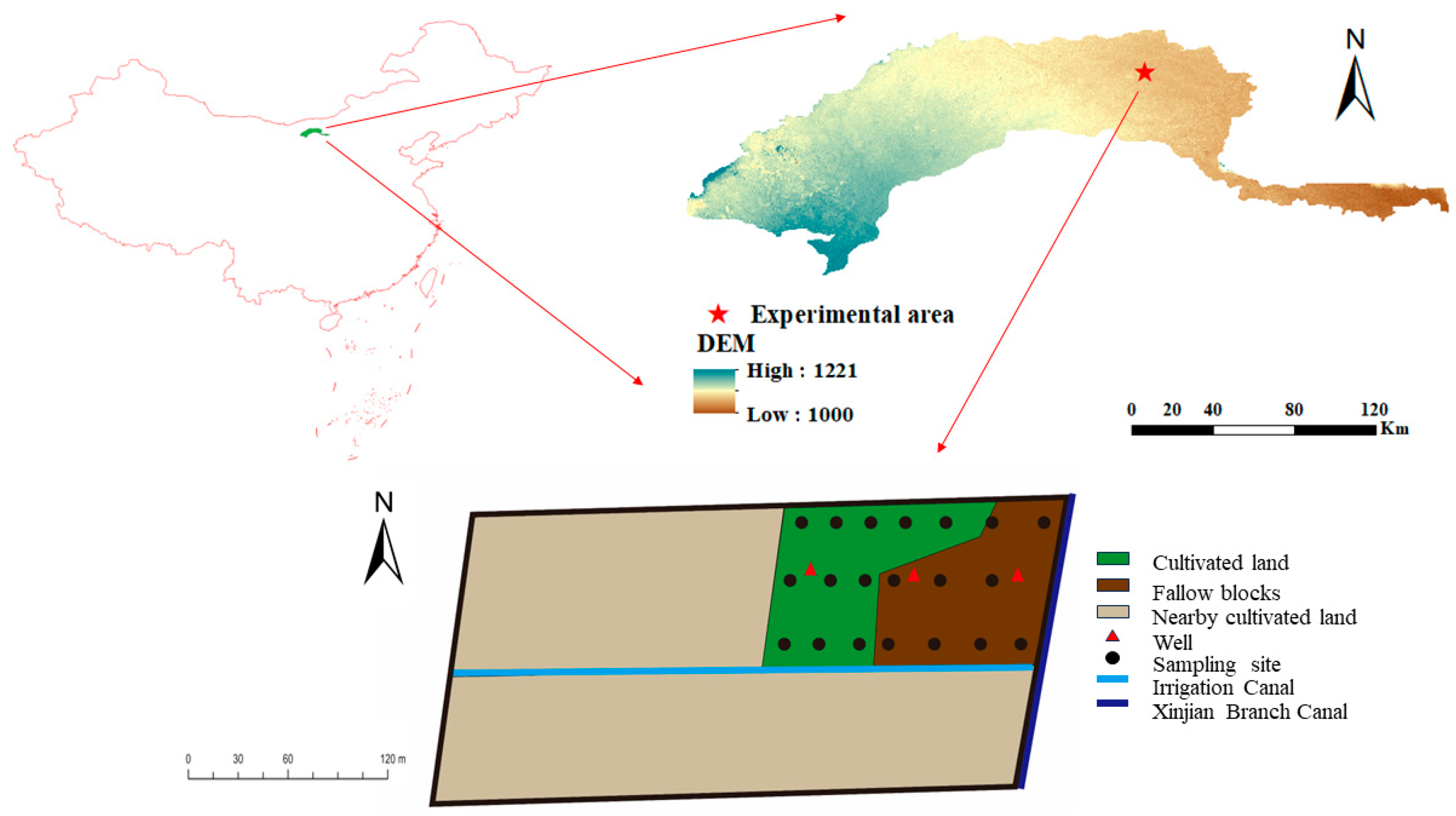
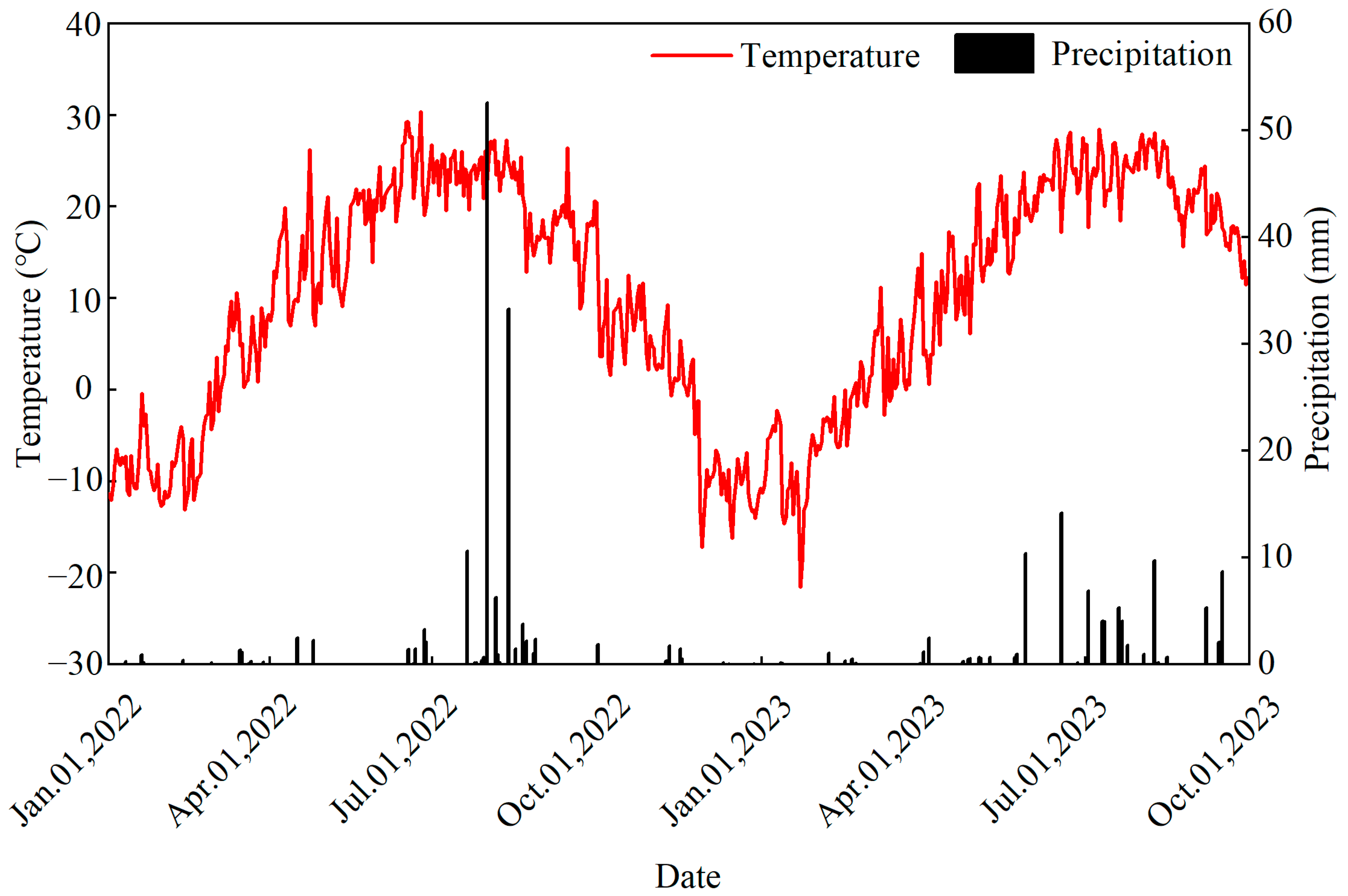
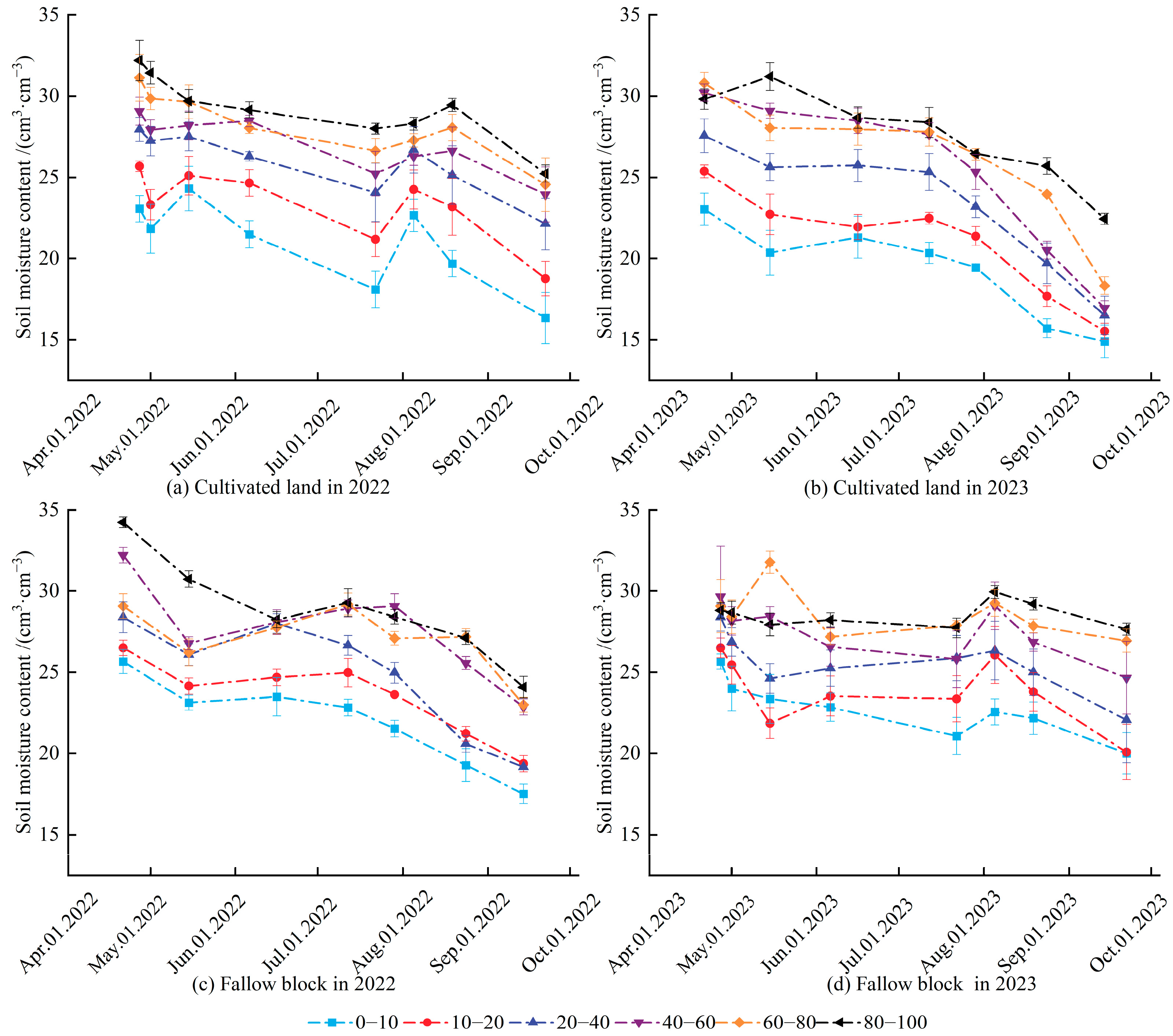
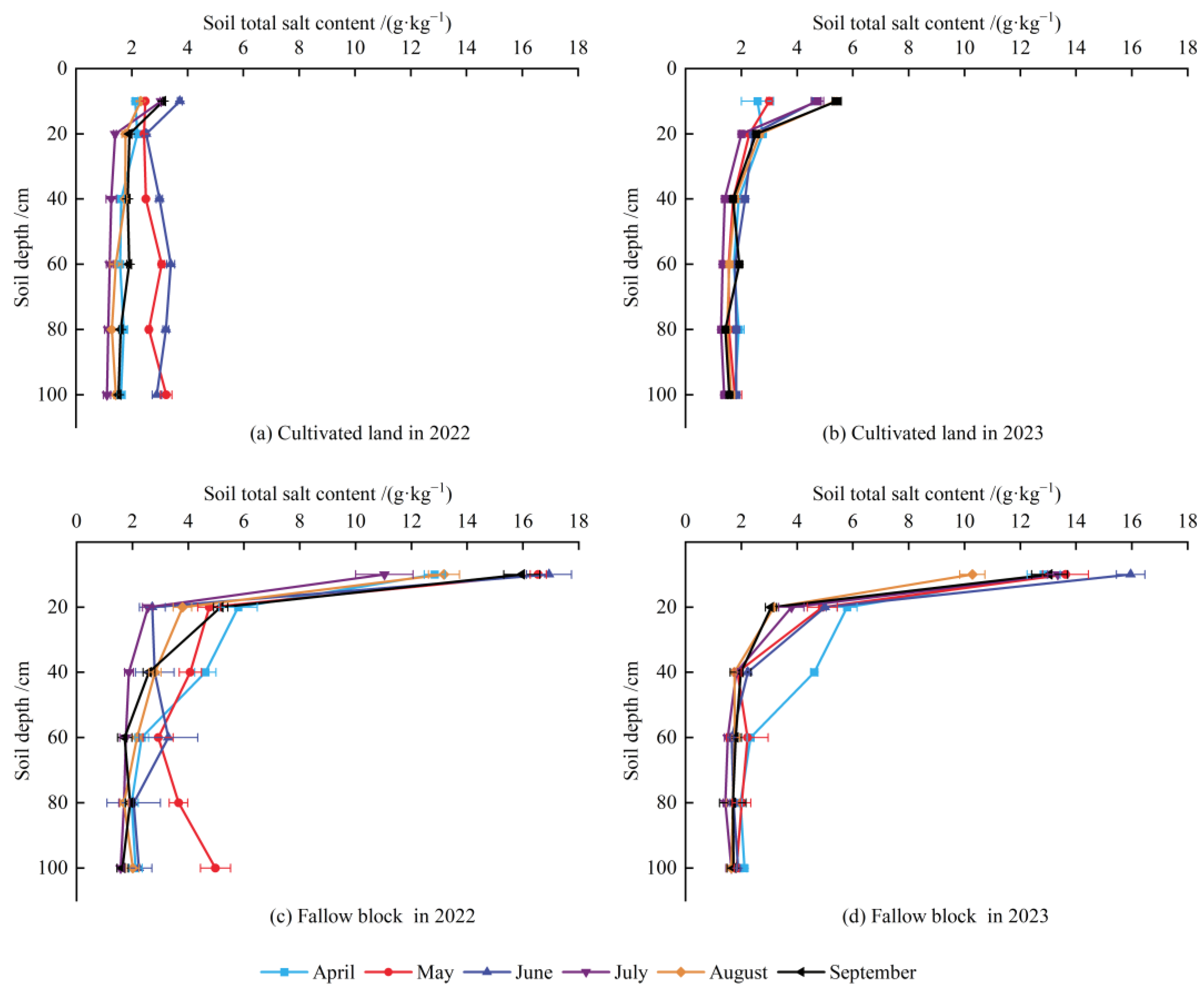
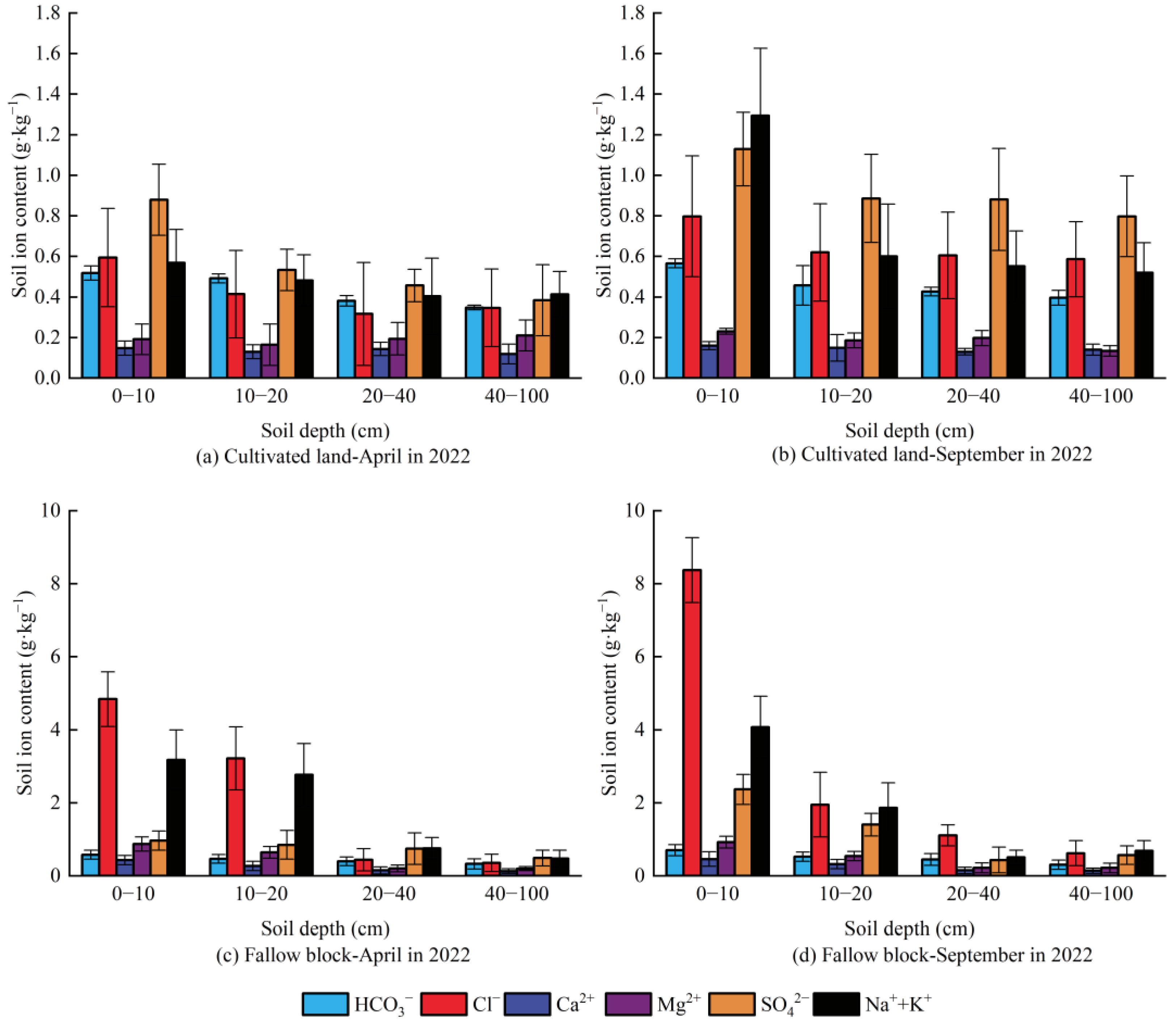
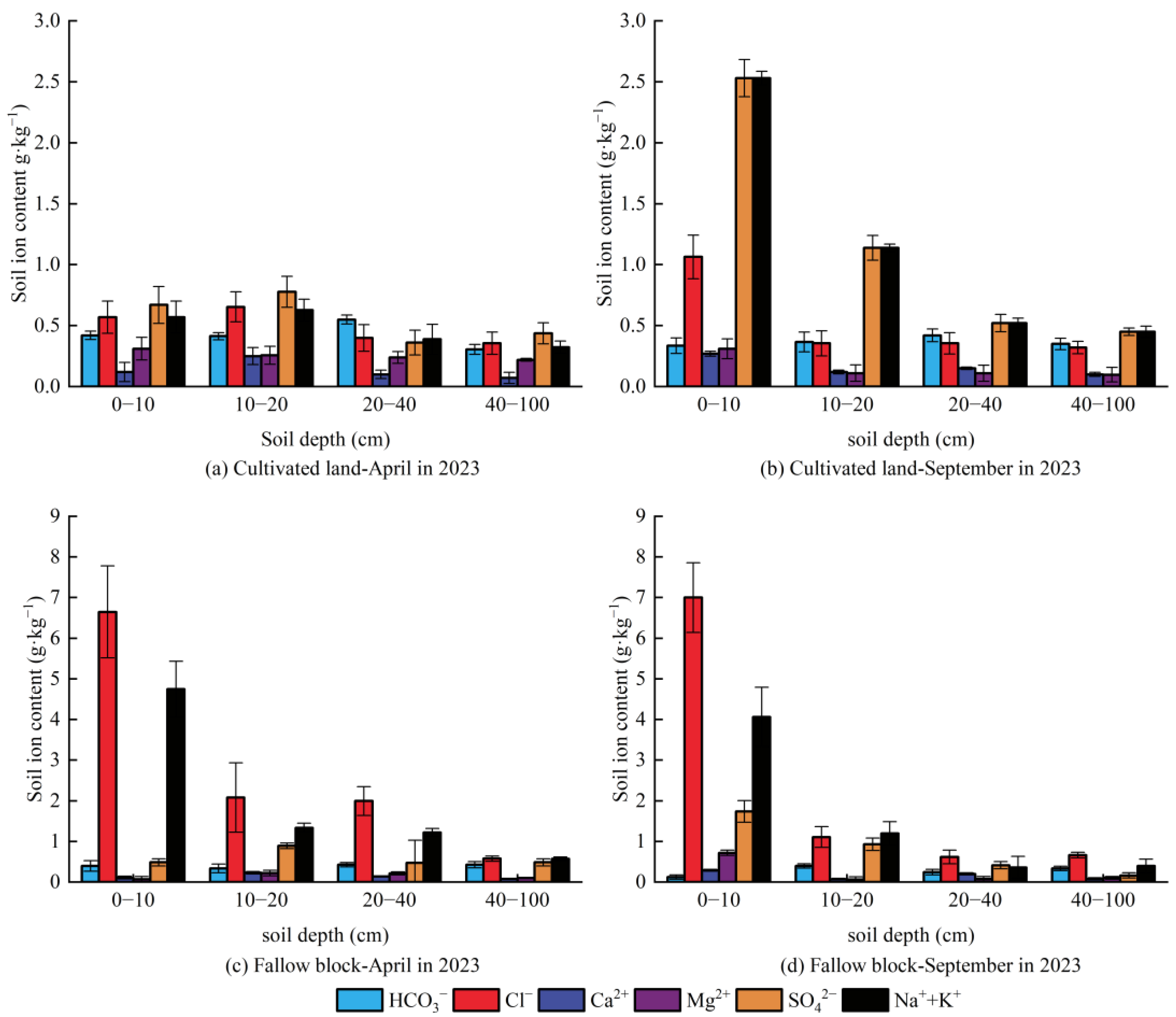
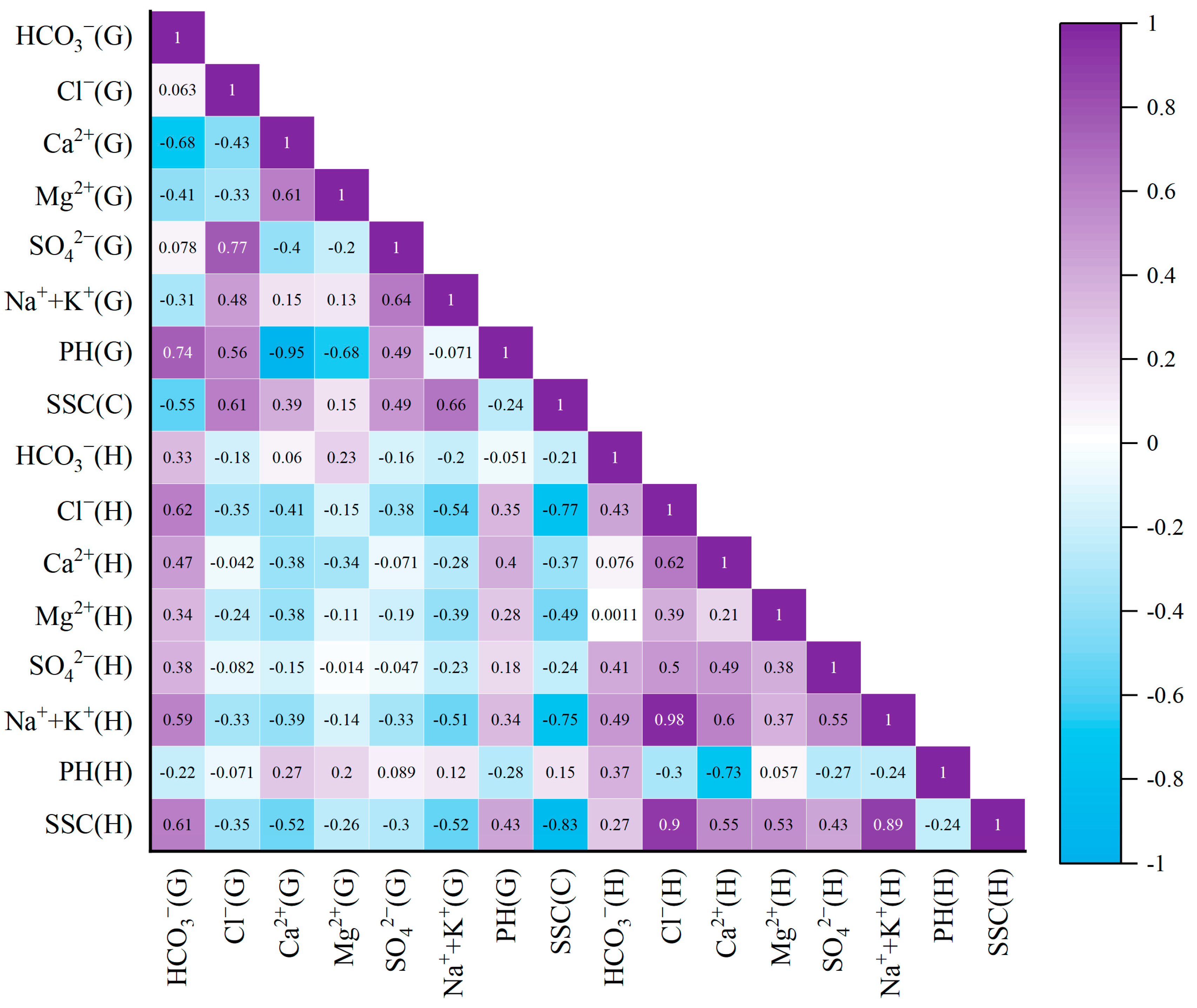
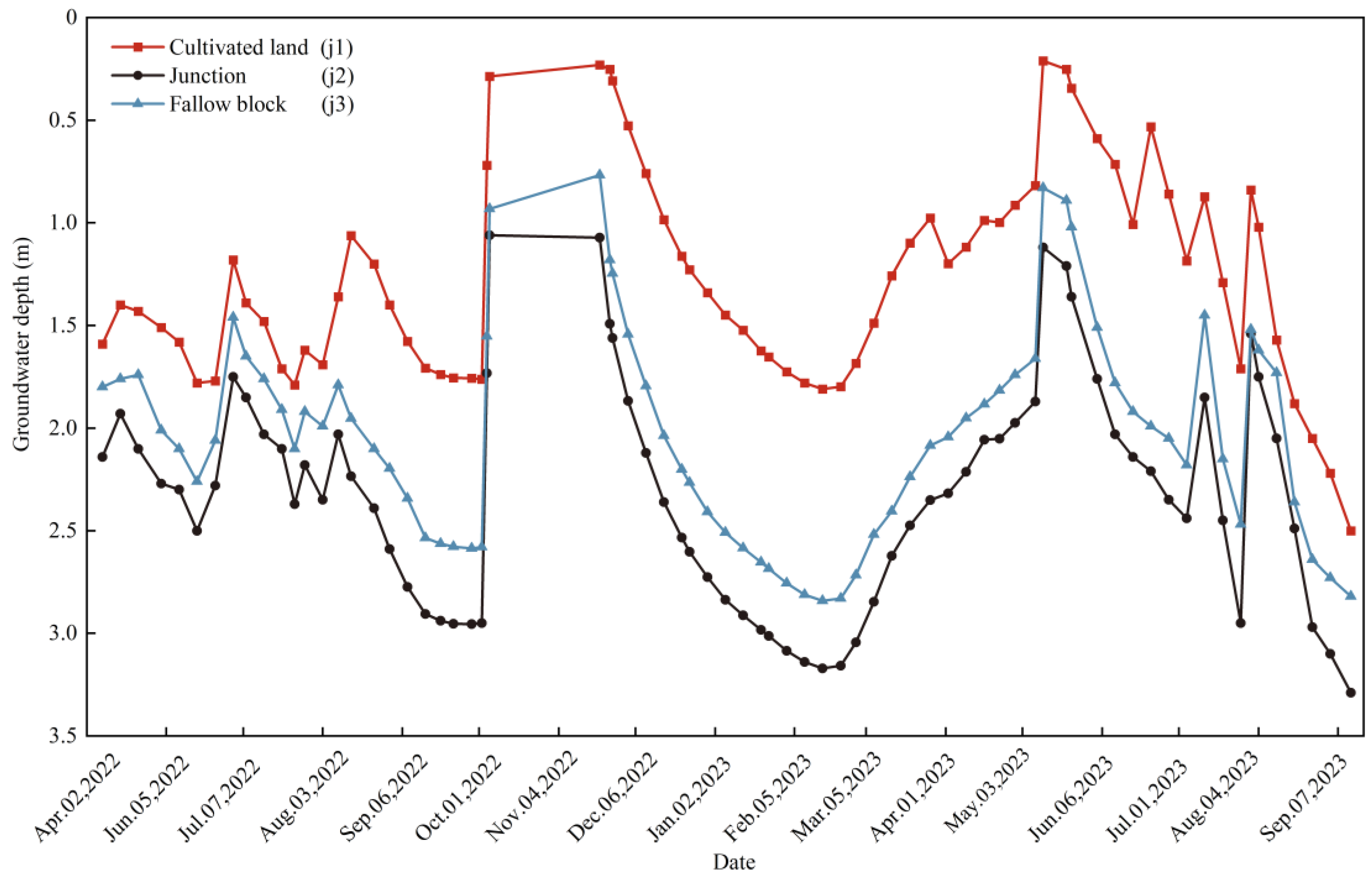
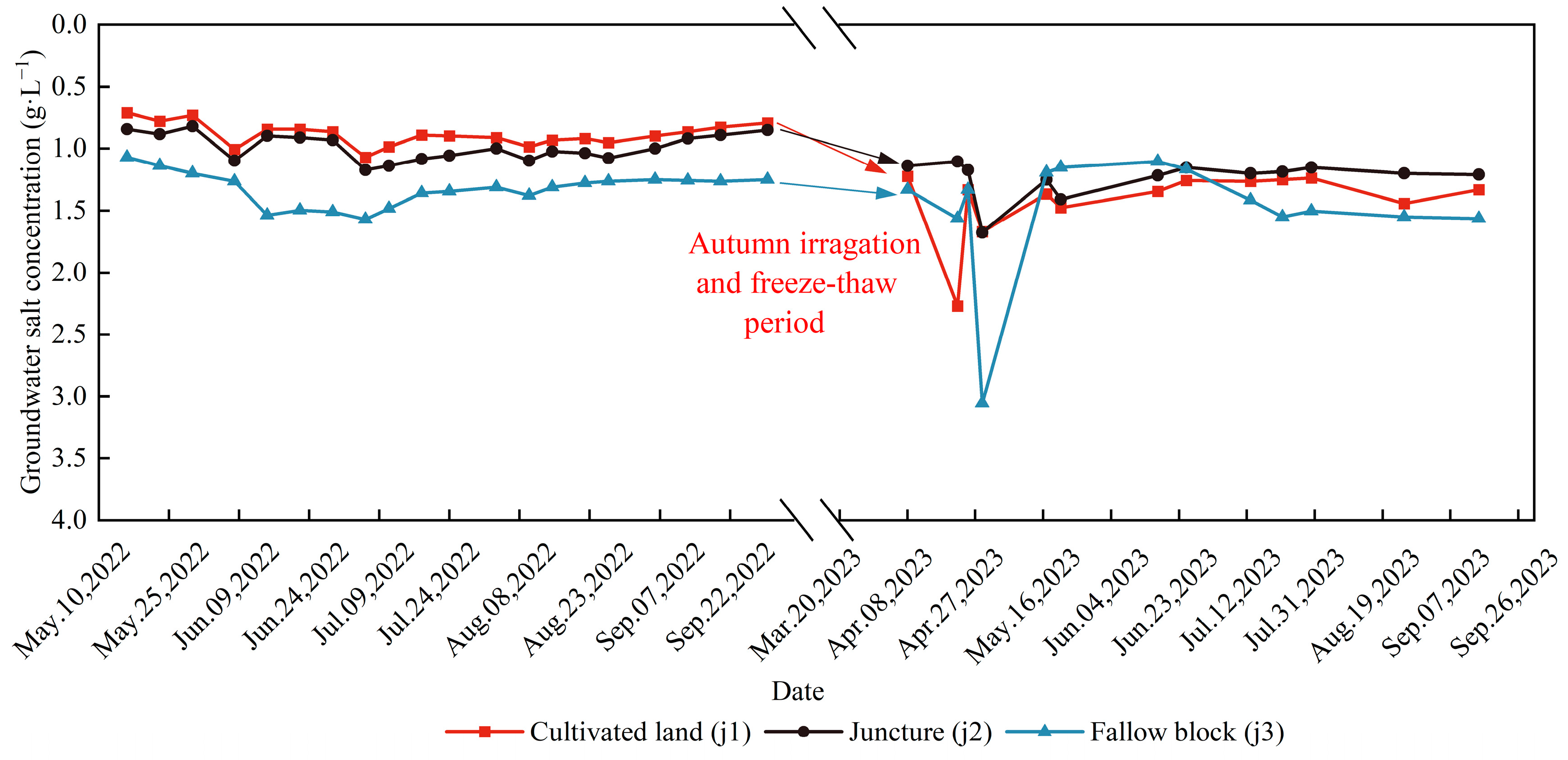
| Land Type | Soil Depth | Sand | Clay | Silt | Soil Texture | Bulk Density | Field Capacity | Saturated Water Capacity |
|---|---|---|---|---|---|---|---|---|
| (cm) | (%) | (%) | (%) | (g·cm−3) | (cm3·cm−3) | (cm3·cm−3) | ||
| 0–10 | 0.32 | 0.06 | 0.62 | Silt Loam | 1.6 | 28.66% | 34.37% | |
| 10–20 | 0.18 | 0.10 | 0.72 | Silt Loam | 1.54 | 27.67% | 26.16% | |
| Cultivated land | 20–40 | 0.29 | 0.07 | 0.64 | Silt Loam | 1.51 | 26.72% | 32.92% |
| 40–60 | 0.03 | 0.16 | 0.81 | Silt Loam | 1.5 | 29.23% | 34.13% | |
| 60–80 | 0.06 | 0.16 | 0.78 | Silt Loam | 1.5 | 32.72% | 37.92% | |
| 80–100 | 0.30 | 0.06 | 0.64 | Silt Loam | 1.47 | 33.27% | 40.36% | |
| 0–10 | 0.19 | 0.05 | 0.76 | Silt Loam | 1.67 | 31.87% | 39.29% | |
| 10–20 | 0.20 | 0.05 | 0.75 | Silt Loam | 1.49 | 28.48% | 34.49% | |
| Fallow block | 20–40 | 0.10 | 0.04 | 0.85 | Silt | 1.48 | 27.89% | 33.57% |
| 40–60 | 0.08 | 0.05 | 0.88 | Silt | 1.45 | 33.33% | 39.33% | |
| 60–80 | 0.07 | 0.06 | 0.87 | Silt | 1.56 | 30.28% | 36.46% | |
| 80–100 | 0.05 | 0.07 | 0.87 | Silt | 1.51 | 31.37% | 39.07% |
| Land Type | Principal Component | Eigenvalue | Contribution/% | Cumulative Contribution/% |
|---|---|---|---|---|
| Cultivated land | PCA1 | 3.902 | 48.769 | 48.769 |
| PCA2 | 1.787 | 22.338 | 71.107 | |
| PCA3 | 1.286 | 16.071 | 87.178 | |
| Fallow black | PCA1′ | 4.221 | 52.766 | 52.766 |
| PCA2′ | 1.633 | 20.413 | 73.179 |
| Land | Principal Component | Coefficients of the Indicators in the Principal Components | |||||||
|---|---|---|---|---|---|---|---|---|---|
| Type | HCO3− | Cl | Ca2+ | Mg2+ | SO42− | Na++K+ | pH | SSC | |
| Cultivated land | PCA1 | −0.196 | 0.934 | 0.658 | −0.223 | 0.819 | 0.92 | 0.345 | 0.934 |
| PCA2 | 0.914 | −0.136 | 0.137 | 0.4 | 0.012 | 0.13 | 0.85 | −0.126 | |
| PCA3 | −0.265 | 0.007 | −0.621 | 0.752 | 0.426 | 0.276 | −0.028 | −0.081 | |
| Fallow block | PCA1′ | 0.434 | 0.947 | 0.75 | 0.494 | 0.684 | 0.947 | −0.386 | 0.905 |
| PCA2′ | 0.715 | 0.099 | −0.525 | 0.157 | 0.044 | 0.129 | 0.884 | 0.112 | |
Disclaimer/Publisher’s Note: The statements, opinions and data contained in all publications are solely those of the individual author(s) and contributor(s) and not of MDPI and/or the editor(s). MDPI and/or the editor(s) disclaim responsibility for any injury to people or property resulting from any ideas, methods, instructions or products referred to in the content. |
© 2023 by the authors. Licensee MDPI, Basel, Switzerland. This article is an open access article distributed under the terms and conditions of the Creative Commons Attribution (CC BY) license (https://creativecommons.org/licenses/by/4.0/).
Share and Cite
Hou, C.; Miao, Q.; Shi, H.; Hu, Z.; Zhao, Y.; Yu, C.; Yan, Y.; Feng, W. Water and Salinity Variation along the Soil Profile and Groundwater Dynamics of a Fallow Cropland System in the Hetao Irrigation District, China. Water 2023, 15, 4098. https://doi.org/10.3390/w15234098
Hou C, Miao Q, Shi H, Hu Z, Zhao Y, Yu C, Yan Y, Feng W. Water and Salinity Variation along the Soil Profile and Groundwater Dynamics of a Fallow Cropland System in the Hetao Irrigation District, China. Water. 2023; 15(23):4098. https://doi.org/10.3390/w15234098
Chicago/Turabian StyleHou, Cong, Qingfeng Miao, Haibin Shi, Zhiyuan Hu, Yi Zhao, Cuicui Yu, Yan Yan, and Weiying Feng. 2023. "Water and Salinity Variation along the Soil Profile and Groundwater Dynamics of a Fallow Cropland System in the Hetao Irrigation District, China" Water 15, no. 23: 4098. https://doi.org/10.3390/w15234098
APA StyleHou, C., Miao, Q., Shi, H., Hu, Z., Zhao, Y., Yu, C., Yan, Y., & Feng, W. (2023). Water and Salinity Variation along the Soil Profile and Groundwater Dynamics of a Fallow Cropland System in the Hetao Irrigation District, China. Water, 15(23), 4098. https://doi.org/10.3390/w15234098









